The Gurkha Museum
 | |
| Founded | 1974 |
|---|---|
| Type | Charitable organisation |
| Focus | Gurkha history |
| Location | |
| Mission | The Gurkha Museum safeguards the heritage of Britain’s Gurkhas through the conservation of records and artefacts relating to the old Indian Army Gurkha Brigade and the present day Brigade of Gurkhas. |
| Website | http://www.thegurkhamuseum.co.uk/ |
The Gurkha Museum commemorates the service of Gurkha soldiers to the British Crown, a relationship that has endured since 1815. It is located in Winchester in Hampshire, England and is part of Winchester's Military Museums.
Besides tableaux, dioramas, showcases and interactive touchscreen displays, there are visual and audio depictions of Nepal and of the Gurkhas' renowned military history, including the award of 26 Victoria Crosses.
There is a Friends of the Gurkha Museum organisation and an annual programme of lectures and events. The Museum is a Registered Charity No. 272426 and the current Chairman of Trustees is Colonel Richard Cawthorne.
History

The Gurkha Museum was first established at Queen Elizabeth Barracks in Church Crookham, Hampshire and was officially opened by the late Field Marshal, the Lord Harding of Petherton, on 21 June 1974. From the beginning it was clear that the Museum, housed in a wooden barrack block, would need larger and more permanent premises. The closure of the Rifle Depot at Peninsula Barracks, Winchester offered this opportunity.
In April 1989 the Museum at Church Crookham was closed and the transfer of the artefacts to Winchester began. Field Marshal, the Lord Bramall of Bushfield officially opened the relocated Museum on 16 July 1990.
Premises

The Gurkha Museum is situated in a main building of the former Rifle Depot at Peninsula Barracks in Winchester. The building was rebuilt after a fire in 1894 destroyed a former royal palace of King Charles II which had been used as a military barracks. It is one of six military museums and collections in Winchester.
Collections
Most of the collections are on the ground and first floors and tell the story of Gurkha service to the Crown in many wars and campaigns. They include uniforms, badges, medals (including 10 of the 26 Gurkha VC's), weapons, war trophies, paintings and pictures.

The displays are chronological, covering the rich history of Gurkha service from 1815 to the present day and the six cap-badged units currently serving in the British Army. These are The Royal Gurkha Rifles, The Queen’s Gurkha Engineers, Queen’s Gurkha Signals, The Queen’s Own Gurkha Logistic Regiment, The Band of the Brigade of Gurkhas and Gurkha Staff and Personnel Support Company.
Archives
There is a reference library, archival and research room on the second floor. The library holds books, documents, photographs, files and maps. It is today a most important source of information about Gurkha regiments and corps, their officers and soldiers.
There is also much information on the history and geography of Nepal, other countries in which Gurkhas have served and on the language of the Gurkhas.
Gurkha 200
2015 marks the bicentenary of Gurkha service to the British Crown. In honour of this historic milestone, various commemorative events will be held throughout the year. The Gurkha Museum will run a special Summer Exhibition in August 2015, portraying 200 years of Gurkha history through 200 objects.
Gurkha Museum Pokhara, Nepal
In 2005, a Gurkha Museum opened near K. I. Singh-Pul in Pokhara, Nepal. It was originally founded already in 1994 at a temporary site in Kathmandu. In the meantime, it has become one of the attractions of the city.[1]
See also
References
- ↑ "Gurkha Museum - Pokhara". 6thgurkhas.org. Retrieved 2016-02-18.
External links
Coordinates: 51°03′45″N 1°19′13″W / 51.0624°N 1.3203°W